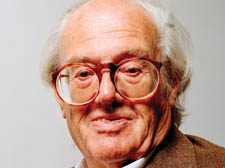|
|
 |
| |

Sir John Mortimer |
Our literary legal lion, who was born on the right side of the Heath
Sir John Mortimer, who died last week aged 85, owed a lot to his early days spent in the leafy surroundings of Hampstead and Downshire Hill,
writes Gerald Isaaman
HE was born in The Pryors, off East Heath Road, and spent his toddler years in elegant Downshire Hill, going to a nursery school in Belsize Park.
And then, in the 15 years making a name for himself as a writer – and as a divorce barrister – he lived in Harben Road, on the Swiss Cottage side of Finchley Road.
So we can truly claim that Sir John Mortimer, who died on Friday, aged 85, best known and loved for his creation of Rumpole of the Bailey, was one of Hampstead’s home-grown literary lions.
“Hampstead did play a vital part in his life,” Valerie Grove, Sir John’s noted authorised biographer, told me at her home in Highgate. “I remember when we did a gig together at Keats House he felt very much that he was in native territory, close to his roots. So the evening had a really special flavour to it.
“The Victorian house in Harben Road, one of just a handful left following the Blitz, was also where he and his late wife, Penelope, wrote all their important work and brought up a family of six children. And it was where they became successful.”
The house was the setting for The Wrong Side of the Park, Sir John’s first West End play, and for a later one, The Collaborators, and it was the scene for Penelope’s brilliant The Pumpkin Eater, alas no longer in print.
“It was a remarkable house,” said Valerie, who knew Sir John for nearly 30 years.
“There was this Dickensian chaos about the place with all those children running around. But John did things like cook the supper for the family.
“He loved having this gang of children around him, and, surprisingly, he could work despite all the noise and the mess they created. They were fantastically important to him.
“So was the John Barnes store, now gone. That was where they shopped, had tea there and had the children measured for shoes.
“Swiss Cottage was all part of their life and image as the writing Mortimers when, in the 1960s, they were seen as the Hampstead writers.”
It was in these years that Sir John, apart from his writing, used his skills as a barrister to defend authors against censorship, though not in the Old Bailey trial of Lady Chatterley’s Lover, despite both BBC and ITV news channels claiming Sir John defended the DH Lawrence novel against the charge of obscenity in 1960.
“He had nothing whatsoever to do with that and it is very misleading – and annoying – for the BBC to make such a mistake,” said Valerie, pointing out that his defence of Last Exit to Brooklyn and the Schoolkids’ Oz trials were the ones that contributed to Sir John’s early legal fame.
But he also made mistakes with his notorious dalliances as a womaniser, his intimate friends including Shirley Anne Field, and, of course, Wendy Craig, with whom he had a love child he only learned about – and met – eight years ago.
He even wanted to bring some of them home. “He had this compulsion to bring the floozie back to meet the wife,” added Valerie. “It was either showing off or maybe a threat to the wife. I don’t know.”
There was even, in his early years, an unfulfilled gay passion for Quentin Edwards QC, the now retired distinguished judge who lives in Pond Square, Highgate.
Their meeting is well documented in Valerie’s biography, but, as she points out now, she sought his permission to mention the liaison.
He agreed provided Sir John found it acceptable. “John wasn’t too keen,” she recalls. “But he sent Quentin a postcard regretting that they had not met since ‘our small scandal at Oxford’.”
It was a sublime example of Sir John’s ability to hide away from unwelcome reality, having in fact appeared in court with Quentin on opposing sides in the 1973 Lady Birdwood blasphemy case.
There was a happy hypocrisy in his attitude to his considerable personal failings, described by VS Pritchett as Sir John’s “moral lassitude”. And he excused himself by insisting he was a champagne socialist dedicated, at least at convenient times, to protecting freedom of speech against censorship and in championing the oppressed and underprivileged.
He espoused his humane principles in his early plays like The Dock Brief, remained the admired author of the screenplay for Brideshead Revisited and, of course, his loveable Horace Rumpole, the anarchic barrister partly based on his late father.
“He is protected by a carapace of national treasurehood, which remains intact,” said Valerie. “I still have great affection for him. And that was what he always wanted – adulation for everything he ever did.” |

|
 |
|
 |
|

